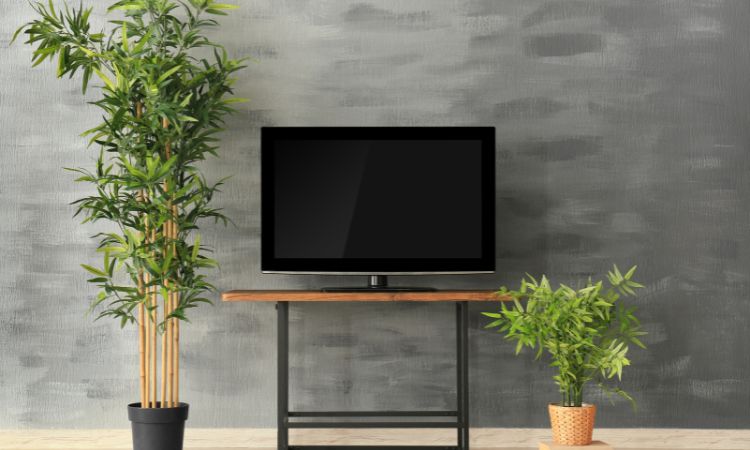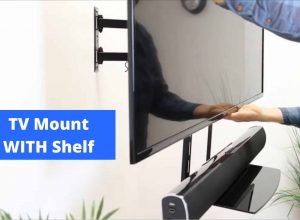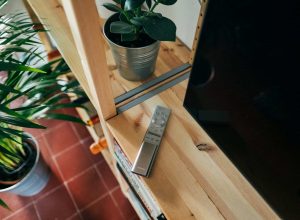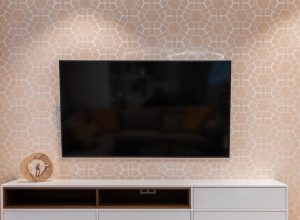An outdoor antenna is an excellent way to get free television channels. You can use HD antennas to watch your favorite shows without compromising the quality and sharpness of your channel.
However, the size of the TV antenna will depend on where you live. Mounting antennas can be difficult as they require time and planning sometimes.
Quick summary
In this post we will go over:
- Types of mounting options
- How to install an antenna?
- Omnidirectional and directional antennas
Without further ado, let’s get started.
Types of Mounting Options
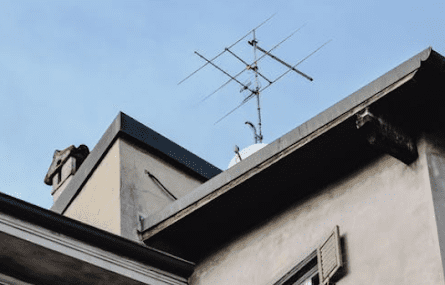
You may already know there are two types of antennas: An outdoor antenna and an indoor antenna.
However, before we get into the detail of TV antennas, we need to look at all the mounting options so you can find the perfect place for the device.
Attic Mounting
If you have an attic, this would be a perfect place to install the TV antenna.
Since attics are at the roofline of most houses, the height of the antenna should be high enough to avoid most obstructions. This will result in less interference and a strong signal.
Where you place your antenna depends on the size of your attic. If you have a large attic we would recommend a pole mount or rotary antenna.
On the other hand, with smaller attics, you may be required to position or clamp the antenna between some floor joists. You might need to drill into the floor of the attic to attach the coaxial cables to the power amp and splitter.
Attic Mounting Options
The size and the location of the antenna will determine the style of what bracket to purchase.
Here are some options for attic mounts for antennas:
- ANTOP Adjustable Attic Antenna Mount
- HD Antenna L Bracket
Roof, Chimney, or Side Mounting
As opposed to attics, Roof mounting will need some extra planning and work for good reception.
If you want a larger antenna, it will most likely come with a mounting system to attach to your roof. You can also mount the antenna on the side of your house or the chimney. Similar to attics, you’ll have to drill holes and snake the coaxial cable to the power booster and splitter,
Note: Don’t forget to ground the antenna through a grounding rod to protect your home from lightning bolts.
Moreover, If you haven’t done this before, we would suggest hiring a handyman to help with the antenna installation.
Roof and Chimney Mount Options:
Here are some options to consider when mounting the rooftop antenna on the roof or side of the house:
- Universal J-Mount.
It will be suitable for most brands and styles of outdoor antennas. The last section of the mount is flexible and telescopes from 24 inches to 44 inches to allow clearance on most pitched roofs.
- Channel Master 3079 Antenna Mast and Pole Mount
The Channel Master 4 inch Wall Mount Kit let you connect an antenna mast, up to 1.5 inches in diameters, to any type of wall. Whereas, the Channel Master 5 inch antenna mast is a 5-foot long, 18-gauge, galvanized steel antenna mast with a wedged end.
- Channel Master CM 3092 3 ft Tripod TV Antenna Mount
Its 3-inch tripod mount is used to hold a TV antenna mast. We would recommend it if you want to mount your antenna on a roof.
- Channel Master CM-3080 Antenna Chimney Mount
This is an excellent kit to secure a TV antenna mast to a chimney.
Rotary Mounts
If you’re unfamiliar with what rotary-mounted antennas are, they are pole-mounted HD antennas with a motor.
They work well on a roof or an attic, Moreover, you can move the antenna 360 degrees.
We found this very helpful since it lets you dial the reception of a particular channel if the broadcast towers are in different locations. However, you will still need to power the motor and controller box.
Rotary Mount Options
- RCA VH226E Programmable Outdoor Antenna Rotator
The RCA VH226E will let you position your TV antenna from a remote location through an electronic control box and control unit. While testing out this antenna, we were able to set up to 12 TV stations for automatic antenna positioning with programmable memory.
In addition, the infrared remote helps you to fine-tune the outdoor antenna from inside your house for the best quality image.
Balcony Mounting
If you live in an apartment or condo, we would recommend a balcony-mounted antenna.
Our team was easily able to install them. Moreover, they come with a clamping system that allows you to mount the antenna to a pole or a railing.
Balcony Mounting Options
An option for balcony mounting is:
- ANTOP UFO 720°Dual-Omni-Directional Antenna
Running Cabling
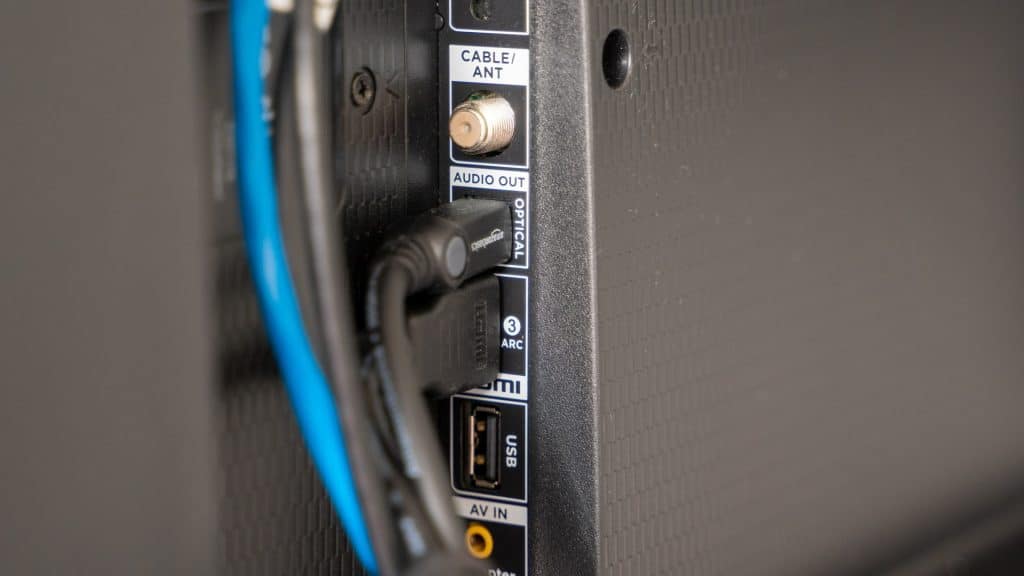
Pre Existing Coaxial Cable
In most houses, there are cables already running for you. If you have wall jacks for cable TV, then you can tap into that existing wiring.
We would highly recommend trying this method. It will save you time, money, and effort. Moreover, you can run your coaxial antenna cable into the nearest wall jack to connect it to the television.
New Coaxial Cabling
If your house does not have existing cabling then you’ll have to snake the wire from the antenna of the television.
You don’t need to be experienced to do this process. However, you don’t think you can manage it, you always hire an electrician to install the wiring.
If you do not have existing cabling installed, then you will have to snake the wiring from the antenna to the television. This can be easily handled by the average handyperson. If you don’t think you can manage it, you can always hire an electrician to install the proper wiring.
Extreme Cases
If you don’t live near a broadcast tower, you will have to take extreme measures to get a channel.
This may need a very large antenna mounted on a long pole or scaffolding for this. It is also important to note that this method may be a hit or a miss, because of the different UHF stations and frequencies.
Things you Need to Install Outdoor Antennas
Indoor antenna and outdoor antenna installation are different. Therefore, it’s hard to give an exact standardized list of tools and parts.
The list would depend on:
- Where you want to install the TV antenna (indoor, outdoor, attic, or roof installation)
- How you will set up the antenna (how many TVs will you connect it to, will you use the cable with the new antenna, etc)
Here is a list of items you will need for most antenna installation:
- Antenna mast
You can get this from a manufacturer or purchase it separately. We would recommend an adjustable outdoor/attic TV antenna mount pole, or a simple PVC pipe from your local hardware store.
Since most antenna masts are made of aluminum they are extremely durable. But, don’t underestimate the power of PVC if you want something light on the pocket.
- Base mount
To mount an antenna on the surface of the roof, you would need a base mount or a tripod. It will hold the mast. We recommend the Heavy Duty Roof Mount for Masts up to 1-7/8″ OD – EZ 19A.
Furthermore, most manufactured masts include base mounts. If you have a PVC pipe, you can buy a swivel mount separately. However, make sure that the diameter of the mount matches the pipe.
- Guy wires to secure the mast
Consider guy wires for masts that are fixed by base mounts and not wall brackets. They are made of galvanized steel to prevent the disruption of TV signals. They are suitable for masts that are 10 feet long.
We would recommend you go for National Hardware N267-013 2573BC for its 6-strand, 20-gauge specification.
- Wall bracket or chimney mount strap
These are perfect to attach your antenna to the side of the house or on the chimney. If your mast is ground-based you may need additional wall brackets to hold it securely.
- U-bolts to secure the antenna to a mast
These come with most outdoor antennas.
- Sealants
You may need different kinds of sealants to waterproof all holes that were made during installation. For example, silicone caulk, roofing tar, or moisture-proof sealing tape.
- Coaxial cable
Coaxial cables that are shipped with the antennas are poorer in quality therefore, we suggest you purchase your own. We recommend you have an extra RG6 coaxial cable with you in case you need to run it further than anticipated, or for replacing a damaged segment.
- Coaxial cable compression fittings
These are used to cap a coaxial cable. It will allow you to plug it into device connectors. We would suggest the GoodQbuy Coax Wire Tools. It is an all-in-one kit that also comes with wire stripping and crimping tools.
- Compass to determine the orientation of the antenna
You will need a compass once you have set your antenna. This will help you get the correct orientation towards a transmission tower. You can also use a smartphone app to do this task.
- A carpenters level tool
This will help you ensure the mast is perfectly vertical for the strongest signals.
- Screwdriver
- Power drill
- Adjustable wrench
- Roofing screws
- Electrical tape
- Digital tuner
How to Install an Outdoor Antenna?
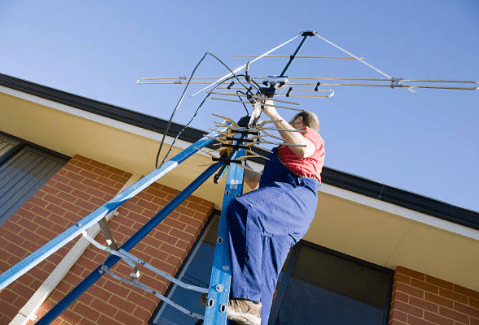
Step 1: Find Your Local TV Stations
TV reception is all about location. Therefore, you need to find the locations of local transmission towers to know exactly what type of antenna you will need and where to face it.
The best place to determine which TV stations and local channels are available is to create a signal report on the TV Fool website.
This will give you a list of real (otherwise known as “RF” or radiofrequency) channels being broadcast in your area in the UHF and VHF bands.
VHF and UHF Channels

Note: Most antennas pick up real broadcast channels for both VHF and UHF frequencies. However, others only pick up either VHF or UHF.
To understand this, let’s go over its background.
In 2009, most stations that used to broadcast on VHF moved to other channels such as UHF. While some stations remained on VHF.
Whereas, most channels moved from UHF channels back to VHF due to the FCC spectrum auction.
So, if you wanted to additionally receive this lone VHF channel, you would need an antenna that receives on both frequencies.
The FCC Channel Repack
From September 2018 to July 2020, many television stations across the United States will change their real channel number as a result of an FCC spectrum auction.
You can go on rabbit ears. info to check whether any local stations on your list will be changing to a different channel number.
Step 2: Select the Correct Antenna

Getting the right antenna may be intimidating with so many options in the market. Instead of stressing yourself about the whole process, get an opinion from a professional on what antenna will work best for you depending on the location.
But, if you have your heart set on selecting an antenna on your own here are a few options:
Small Multi-Directional
They are the smaller antennas available but they receive great signals from different directions.
Medium Multi-Directional
Compared to small multi-directional antennas, they are a bit bigger and more powerful. It comes with a novel stick and wing-shaped long elements.
Large Multi-Directional
It receives more power signals due to its large size. We would recommend this for people who live far away from the signal source.
Small Directional
This antenna delivers perfect picture quality but only in the absence of signal reflecting structures.
Medium Directional
This is a great choice for its grain-reducing characteristics and good size.
Large Directional
We would recommend you to get this antenna if you live in an area with the weakest signals due to maximum TV reception.
Step 3: Prep for Antenna Installation
Before you install the antennas, you need to get familiar with the different channels and their corresponding compass headings. You can also contact a local professional for this information.
Next, make sure the mounting bracket is secured to the roof according to the instructions of the mounting kit. We also used roofing screws and silicone bolts to make sure they are protected from water.
In addition, if you want your outdoor TV antennas installed through a wall mount, we suggest you drill holes into the wall.
However, make sure you leave 12 to 14 inches of space between the top and bottom brace. This will stop the antenna pole to sway in strong winds.
Step 4: Build the Outdoor TV Antenna and the Pole
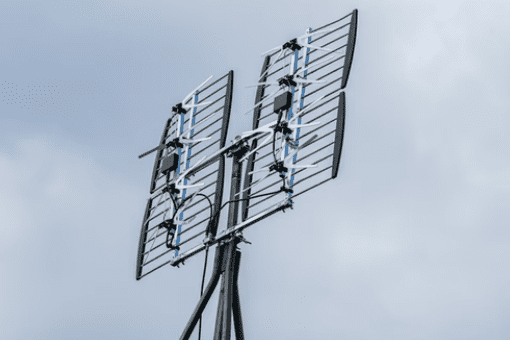
Again, this depends on the type of antenna you bought. Most antennas come in one piece while others have to be assembled.
Once the antenna is built and ready, you can go ahead and loosen the screws on the sleeve of the mounting bracket. This will help you easily slide the pole on the bottom sleeve.
Don’t forget to secure the pole by tightening the bolts.
Step 5: Connect the Outdoor Antenna to the Pole
Once you have loosened the screws of the antenna sleeve, slide it slowly over the pole. You need to make sure the top meets the pole’s sleeve.
Next, gently change the antenna position to the direction of the broadcast tower. Do not completely tighten the bolts yet because you may need to adjust the antenna’s direction again.
Step 6: Connect the Antenna to a TV
This is where you fix your antenna to a television through an appropriate coaxial cable.
Note: Remember to check the end of the cable to see if it is attached to the cable output terminal of the antenna and the other end is on the coaxial input of the television.
Ask the help of a partner to tune in different channels while you adjust the direction of the antenna.
Once everything is in place, attach the antenna to the pole and tighten the bolts. We would recommend you use insulated U-clamp nails or a nail gun to make sure the cables are in place.
Step 7: Electrical Grounding & Signal Splitting
Note: Don’t forget to ground the antenna for safety.
You can do this by using a grounding block. It will establish a connection from your house to the ground.
Also, ensure that you follow the appropriate electric codes of your location.
The last step is to connect the coaxial cable to a splitter so that you can enjoy your favorite shows from anywhere in the house.
While working with outdoor antennas, you will need to climb onto your roof. This might be extremely dangerous. So, it’s always a good idea to consider a professional to get the job done.
Directional or Omnidirectional Antennas?

Now that you know how to install an antenna in detail, let’s talk about directional and omnidirectional antennas.
An outdoor TV antenna is usually directional. This means they are optimized to receive signals from specific directions instead of 360 degrees around.
If you are successful in accurately placing a directional antenna towards broadcast towers, you will get stronger signal strength and long-range reception.
As you already guessed, indoor antennas are omnidirectional. They work best when your surrounding area is flat as opposed to hilly mountains. Moreover, they need to be 15 to 20 miles from a broadcast tower.
Antenna Range
To know the antenna range, we suggest you check the antenna description. Each antenna has its own specific reception range.
The range is assigned to each antenna according to the antenna’s design and by testing it under ideal conditions. But, it is important to note that the range stated on the box may not be valid under all conditions.
For example, if you live next to tall buildings, this will result in blocked or weaker signals. This will shorten the indicated distance mentioned in the box.
This is extremely important to bear in mind. Where you decide to place your antenna or if you amplify it, your antenna should still pick up weak signals and transmit them to your TV.
Therefore, before you purchase an antenna, get the locations and distances of local broadcast towers in order to get one with a sufficient reception range.
Another thing to keep in mind is that some manufacturers overstate their range. For example, they may advertise them by stating that the range is 80 miles, which is farther than the natural curvature of the earth.
Remember that despite such stated ranges, most antennas will not receive signals beyond 60-80 miles.
CTA Color Codes

If you’re purchased an antenna before, you may have noticed CTA color ratings on the side of the box.
Antennas are allotted a color code that depends on their classification by the Consumer Technology Association. These colors indicate the antenna reception qualities like size, directionality, and distance rating.
Furthermore, the color codes apply to outdoor antennas only.
Here are some of the CTA color codes:
- Yellow (15 miles from towers or less)
Small Omni or directional outdoor TV antennas that need the strongest signals.
- Green (30 miles from towers or less)
Medium Omni- or directional antennas that need good signal strength
- Gray(30 miles from towers or less)
Medium Omni- or directional antennas for areas with weaker signals than green, perhaps requiring amplification.
- Red (45 miles from towers or less)
Medium directional antennas for areas with weaker signals.
- Blue (60 miles from stations or less)
Medium directional antennas for areas with weaker signals, that need amplification, installed on towers or high rooftops.
- Purple (60 miles from stations or more)
Large directional antennas with amplification for areas far from stations, installed on towers or high rooftops .
Wrapping Things Up…
With that, we conclude our post. Installing an antenna may look complicated but it’s not that hard.
You need to be patient and have time for the preparation and installation process. The end result will be worth it for an excellent quality picture on your new TV.
If you’re still apprehensive, you can always contact a professional to set it up for you.
Adam F.
A/V and Home Theater Expert that focuses on providing clear as well as concise reviews for anything and everything Audio Visual. From TV's, TV Mounts, Soundbars, and Wiring, my focus is to provide expertise in everything Audio Visual focused.


